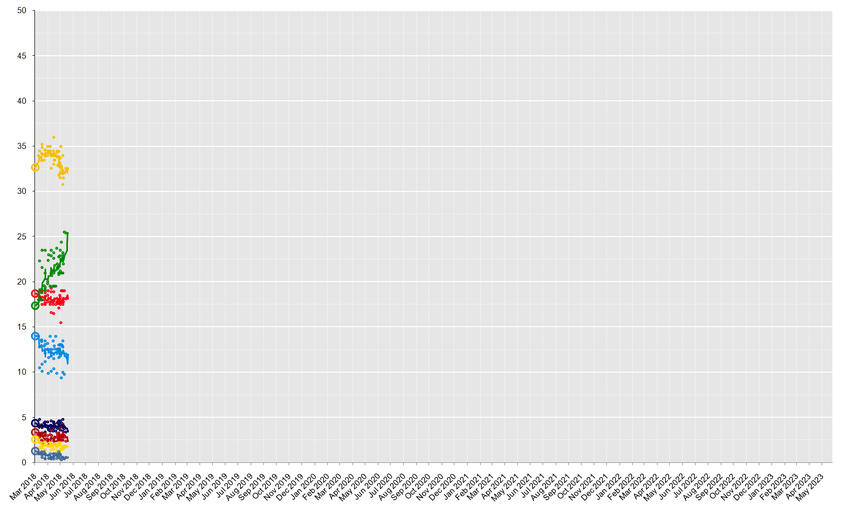Next Italian general election
|
| |||||||||||||||||||||||||||||||||||||||||||||||||||||||||||||
| |||||||||||||||||||||||||||||||||||||||||||||||||||||||||||||
All 630 seats in the Chamber of Deputies and 315 (out of 321) seats in the Senate of the Republic | |||||||||||||||||||||||||||||||||||||||||||||||||||||||||||||
|---|---|---|---|---|---|---|---|---|---|---|---|---|---|---|---|---|---|---|---|---|---|---|---|---|---|---|---|---|---|---|---|---|---|---|---|---|---|---|---|---|---|---|---|---|---|---|---|---|---|---|---|---|---|---|---|---|---|---|---|---|---|
| Opinion polls | |||||||||||||||||||||||||||||||||||||||||||||||||||||||||||||
| |||||||||||||||||||||||||||||||||||||||||||||||||||||||||||||
| |||||||||||||||||||||||||||||||||||||||||||||||||||||||||||||
The next Italian general election is due to be held on or before 28 May 2023.
Under the current Constitution, voters would elect 630 members of the Chamber of Deputies and 315 members of the Senate of the Republic for the 19th Parliament of Italy.
Electoral system
The electoral system is a parallel voting system, with 37% of seats allocated using first-past-the-post voting (FPTP) and 63% using proportional representation, allocated with the largest remainder method, with one round of voting.[1][2]
The 630 deputies are elected in:[3]
- 232 in single-member constituencies, by plurality;
- 386 in multi-member constituencies, by national proportional representation;
- 12 in multi-member abroad constituencies, by constituency proportional representation.
The 315 elected senators are elected in:[3]
- 116 in single-member constituencies, by plurality;
- 193 in multi-member constituencies, by regional proportional representation;
- 6 in multi-member abroad constituencies, by constituency proportional representation.
A small, variable number of senators for life are also members of the Senate.
For Italian residents, each house members are elected by single ballots, including the constituency candidate and his/her supporting party lists. In each single-member constituency the deputy/senator is elected on a plurality basis, while the seats in multi-member constituencies will be allocated nationally. In order to be calculated in single-member constituency results, parties need to obtain at least 1% of the national vote. In order to receive seats in multi-member constituencies, parties need to obtain at least 3% of the national vote. Elects from multi-member constituencies will come from closed lists.[4]
The single voting paper, containing both first-past-the-post candidates and the party lists, shows the names of the candidates to single-member constituencies and, in close conjunction with them, the symbols of the linked lists for the proportional part, each one with a list of the relative candidates.[5]
The voter can cast their vote in three different ways:[6]
- Drawing a sign on the symbol of a list: in this case the vote extends to the candidate in the single-member constituency which is supported by that list.
- Drawing a sign on the name of the candidate of the single-member constituency and another one on the symbol of one list that supports them: the result is the same as that described above; it is not allowed, under penalty of annulment, the panachage, so the voter can not vote simultaneously for a candidate in the FPTP constituency and for a list which is not linked to them.
- Drawing a sign only on the name of the candidate for the FPTP constituency, without indicating any list: in this case, the vote is valid for the candidate in the single-member constituency and also automatically extended to the list that supports them; if that candidate is however connected to several lists, the vote is divided proportionally between them, based on the votes that each one has obtained in that constituency.
Parties and leaders
This is a list of the main active parties which would likely participate in the election and are polled in most opinion surveys.
| Party | Ideology | Leader | Current Seats | ||
|---|---|---|---|---|---|
| Deputies | Senators | ||||
| Five Star Movement (M5S) | Populism | Luigi Di Maio | |||
| League (LN) | Right-wing populism | Matteo Salvini | |||
| Democratic Party (PD) | Social democracy | Maurizio Martina | |||
| Forza Italia (FI) | Liberal conservatism | Silvio Berlusconi | |||
| Brothers of Italy (FdI) | National conservatism | Giorgia Meloni | |||
| Free and Equal (LeU) | Social democracy | Pietro Grasso | |||
| More Europe (+E) | Liberalism | Emma Bonino | |||
| Us with Italy (NcI) | Christian democracy | Raffaele Fitto | |||
Opinion polls
Notes
References
- ↑ Giuseppe Alberto Falci (2017-03-10). "Rosatellum, come funziona la legge elettorale e cosa prevede". Corriere.it. Retrieved 2018-03-04.
- ↑ "Rosatellum 2.0, tutti i rischi del nuovo Patto del Nazareno". Ilsole24ore.com. 2017-09-21. Retrieved 2018-03-04.
- 1 2 Chughtai, Alia (4 March 2018). "Understanding Italian elections 2018". Al Jazeera. Retrieved 6 March 2018.
- ↑ Pregliasco, Lorenzo; Cavallaro, Matteo (15 January 2018). "'Hand-to-hand' combat in Italy's election". Politico. Retrieved 6 March 2018.
- ↑ "Elezioni, come si vota con il Rosatellum, debutta la nuova scheda elettorale". Today.it. 2017-10-20. Retrieved 2018-03-04.
- ↑ AGI - Agenzia Giornalistica Italia (2017-07-23). "Il Rosatellum bis è legge. Ma come funziona?". Agi.it. Retrieved 2018-03-04.

.jpg)



.jpg)
